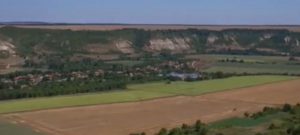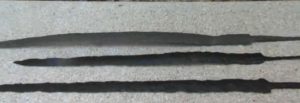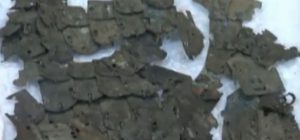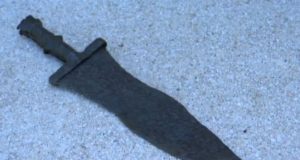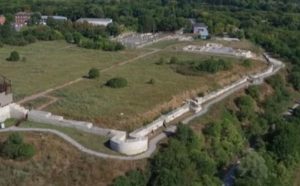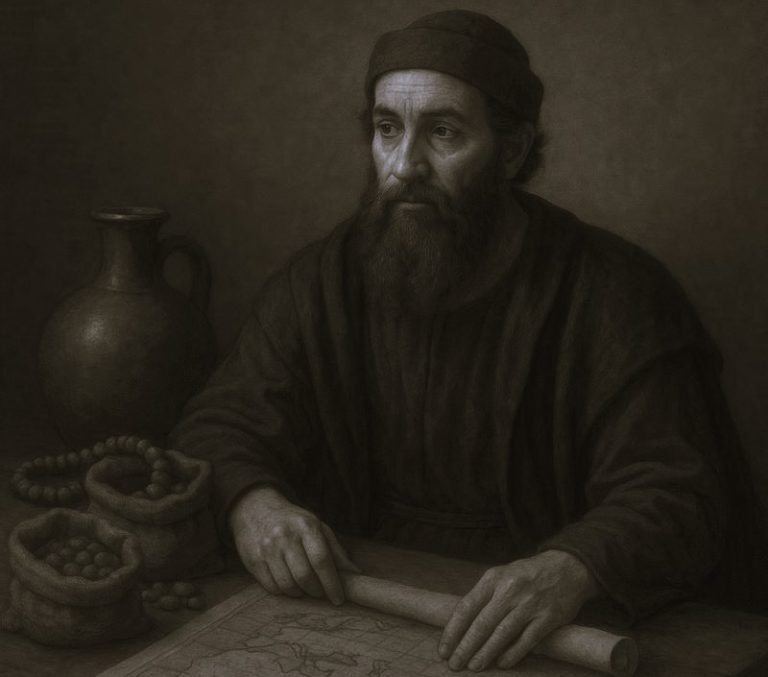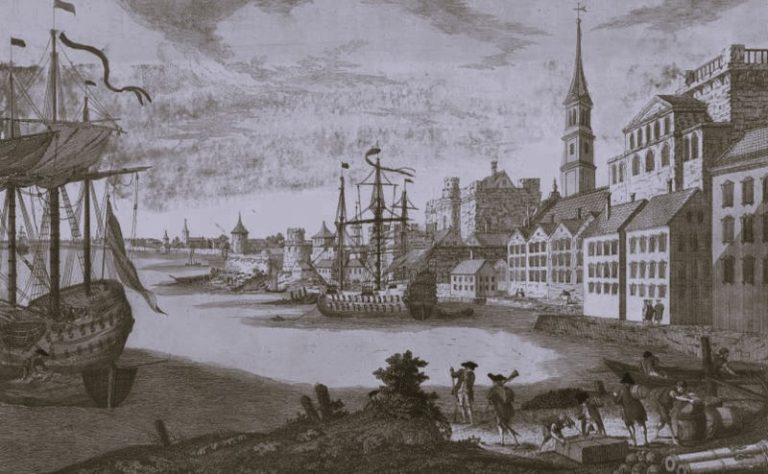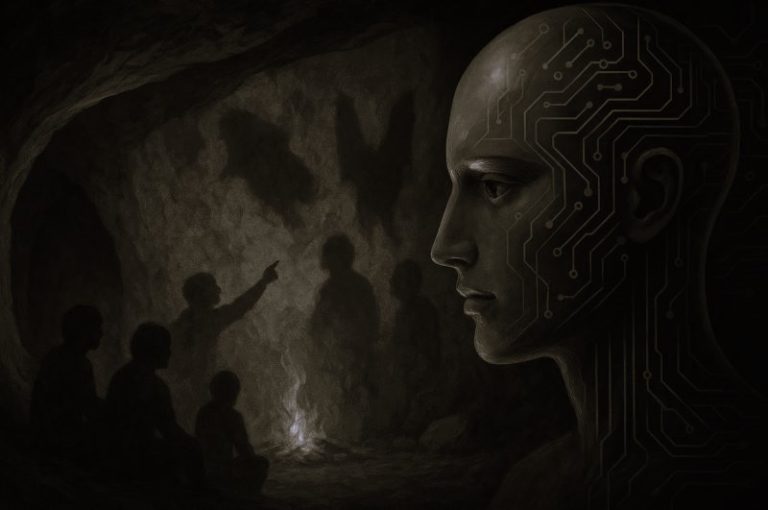The field near the town of Dryanovets in Northeast Bulgaria where the Battle of Abritus between Rome and the Goths took place 1765 years ago. Photo: TV grab from BNT
By Ivan Dikov / 09.15.2016
The battlefield of one of the greatest battles in the Late Antiquity, the 251 AD Battle of Abritus between the Roman Empire and the invading Goths, which is known for the deaths of two Roman Emperors, has been identified by Bulgarian archaeologists near the town of Dryanovets in Northeast Bulgaria.
In the Battle of Abritus in July 251 AD, 1765 years ago,Roman forces were routed during the barbarian invasion of the Goths, and Roman Emperor Trajan Decius (r. 249-251 AD) and his co-emperor and son Herennius Etruscus (r. 251 AD) were killed.
Trajan Decius and Herennius Etruscus thus became the first Roman Emperors to perish in battle with the invading barbarians – as did later Roman Emperor Valens in the 378 AD Battle of Adrianople.
(Technically, the next Roman Emperor to perish in battle was Eastern Roman (Byzantine) Emperor Nicephorus I (r. 802-811) who was killed in the Battle of the Varbitsa Pass (Battle of Pliska) against the forces of Khan Krum of the First Bulgarian Empire. His son and successor on the throne Emperor Stauracius also died two months later of the wounds he sustained in the same battle.)
Abritus, whose ruins are located near the city of Razgrad in Northeast Bulgaria, first emerged as an Ancient Thracian settlement established no later than the 5th century BC. It saw its height as a Roman and later Byzantine city in the Late Antiquity.
The Abritus Archaeological Preserve was established by the Bulgarian government in 1984 on a territory of about 1,000 decares (app. 250 acres) including monuments from Ancient Thrace, Ancient Rome, and the medieval Bulgarian Empire.
In 2014, Razgrad Municipality carried out partial archaeological conservation and restoration of the Ancient Roman city Abritus, a project worth BGN 6.2 million (app. EUR 3.17 million) most of which was EU funding. However, much of the vast area of Abritus remains unexplored.
The field near the town of Dryanovets in Northeast Bulgaria where the Battle of Abritus between Rome and the Goths took place 1765 years ago. Photo: TV grab from BNT
Yet, the Bulgarian archaeologists have managed to identify for sure the battlefield of the Battle of Abritus at a location near today’s town of Dryanovets, about 15 km northwest of Razgrad, and, respectively, Abritus, in the valley of the Beli Lom River, reports the Bulgarian National Television.
“[Based on] the available archaeological and numismatic finds, we have concluded that the last camp of Emperor Trajan Decius was located in this area, and the battle itself took place along the valley of the Beli Lom River, at the foot of a hill,” explains archaeologist Georgi Dzanev, a numismatist at the Razgrad Regional Museum of History, who is also the deputy head of the excavations of the city of Abritus.
Both the archaeologists and the local residents have discovered a large number of Roman Era arms such as parts of swords, shields, spears, armors, greaves, and even poles from military tents on the battlefield of the Battle of Abritus between the Goths and the Romans.
In 250 AD, about 70,000 Goths led by Gothic chieftain Cniva invaded the Roman Empire by crossing the Danube at Novae. They were initially halted by Emperor Trajan Decius at Nicopolis ad Istrum (today’s Nikyup) but then went on to raid a number of Roman cities reaching as far south as Philipopolis (today’s Plovdiv) which was ransacked.
Upon returning retreated north, from Thrace into Moesia, the Goths were met by the forces of Emperor Trajan Decius and his son Herennius Etruscus.
Dzanev says Roman Emperor Trajan Decius probably selected deliberately the location of the battlefield where he met the Goths because of the flat terrain which gave the Roman legions an advantage.
“Emperor Trajan Decius had been a provincial governor here, in Moesia Inferior. Having had information about the movement of the Goths, who were retreating from Thrace, perhaps he decided to face them here on purpose,” adds the archaeologist.
Yet, the Battle of Abritus eventually did not play out as planned by the Romans. In the course of the battle, Goth chieftain Cniva managed to lure the Romans to the nearby marshes.
“If we are to believe a later author, Ammianus Marcellinus, Emperor Trajan Decius perished in a swamp. There is an area here, near the town of Dryanovets which until recently was known as “büyük göl” (Turkish words left over from the Ottoman period meaning “a large lake” – editor’s note),” adds Dzanev.
Ancient Roman weaponry discovered on the site of the battlefield of the Battle of Abritus. Photos: TV grabs from BNT
Even though the powerful Roman Empire persisted into the Late Antiquity, and was later succeeded by the Eastern Roman Empire (Byzantium), it is sometimes pointed out that the Battle of Abritus with the deaths of not one but two Roman Emperors on the battlefield might have signaled the beginning of the end of the Empire’s might.
The city of Abritus was fortified more heavily long after the battle, with the construction at the beginning of the 4th century AD, during the reign of Roman Emperor Constantine I the Great (r. 306-337 AD). In the Late Roman and Early Byzantine period it had a total fortified area of 150 decares (app. 37 acres), four gates, and 35 fortress towers, and an unfortified civilian settlement located on a territory of another 150 decares outside the fortress walls.
Regardless of its robust defenses, however, the Late Antiquity Roman city of Abritus was conquered and ransacked several times by barbarian tribes, including by the Goths in 251 AD, and in 376-378 AD, the Huns of Attila in 447 AD, and the Avars and Slavs in 586 AD.
Aerial views of the partly restored ruins of ancient Abritus near Bulgaria’s Razgrad. Photos: TV grabs from BNT
The ruins of the Ancient Thracian and Roman city of Abritus are located outside the northeastern Bulgarian city of Razgrad. For a long time, in the 19th and the first half of the 20th century, the Bulgarian archaeologists and historians thought the Zaldapa Fortress located further to the northeast was the city of Abritus because of the name of the small town of Abrit located near Zaldapa. However, the ruins of Abritus were discovered some 100 km to the southwest, near the city of Razgrad, in 1953. The ruins of Abritus were identified after the discovery of an inscription fragment reading “Abr…”. In 1980, on its outskirts Bulgarian archaeologists found a limestone roadside pillar from the reign of Roman Emperor Philip the Arab (r. 244-249 AD) reading in Latin that it stood 1 Roman mile (1,492 meters) from Abritus. The name Abritus was also written on a limestone sacrificial altar dedicated to Hercules (Heracles) dated between 139 and 161 AD, which was found in 1954. The name Abritus is believed to stem from the Latin words “abrumpo” (terminate, interrupt) and abruptus (steepness, slope), and is taken to mean an “interrupted slope”.
Abritus (today’s Razgrad) was first an Ancient Thracian settlement established no later than the 5th century BC, and possibly even earlier, with archaeological excavations revealing Late Bronze Age Thracian homes, and Ancient Greek coins of Macedon King Philip II (r. 359-336 BC), and Alexander the Great (r. 336-323 AD), Thracian King Seuthes III of the Odrysian Kingdom (r. ca. 330-ca. 300 AD), and from the Ancient Greek colon of Odessos (today’s Varna) in the 3rd-2nd century BC. An inscription in Ancient Greek discovered in Abritus in 1953 from the 20s AD is dedicated to god Apollo. It dates to the reign of Thracian King Rhoemetalces II, who was a “Client Ruler” in association with his mother Antonia Tryphaena of the Odrysian Kingdom of Thrace under the Romans from 18 to 38 AD. Rhoemetacles is known to have crushed Thracian rebellions against the Romans who declared him “King of the Thracians”. Bulgarian archaeologists believe that the Thracian population of Abritus before the establishment of the Roman city consisted of Odrysians (Odrysae) and Gets (Getae), as well as possibly Celts.
The Ancient Roman city of Abritus was built in the 1st century AD on top of an Ancient Thracian settlement; later Abritus became one of the most important Roman cities in the province of Moesia Inferior. It is believed that the Roman city started as a Roman military camp of Сohors II Lucensium around 78 AD, during the reign of Emperor Vespasian (r. 69-79 AD), while some historians believe that the city was founded by Emperor Trajan (r. 98-117 AD). The earliest testimony about the stationing of the Roman cohort Cohors II Lucensium on the territory of today’s Bulgaria is a Roman military diploma from January 7, 78 AD, found in the Roman city of Montanesium, today’s Montana in Northwest Bulgaria. It is also known that in 136 AD Cohors II Lucensium was stationed in Kabile, one of the Ancient Thracians capitals, located near today’s Bulgarian city of Yambol.
The civilian Roman settlement, the so called сanabae legionis, emerged at the end of the 1st and the beginning of the 2nd century AD. Towards the end of the 3rd century AD Abritus acquired many urban features, and in the 4th century AD it was mentioned as a civitas, a city. Abritus was one of the fortifications on one of the main north-south Roman roads going through Sexaginta Prista (today’s Ruse), Marcianopolis or Marcianople (today’s Devnya) – Mesembria (today’s Nessebar) – Deultum (today’s Debelt) – Adrianople (Odrin, today’s Edirne in Turkey). Two other east-west secondary Roman roads passed near it was well: Sexaginta Prista – Marcianopolis – Odessos (today’s Varna), and Nicopolis ad Istrum – Marcianopolis – Odessos. In the later Roman period, the population of Abritus consisted of Romans, Thracians, Greeks, and other settlers from the eastern provinces of the Roman Empire. It worshipped the Roman deities from the Capitoline Triad – Jupiter, Juno, and Minerva, as well as Hercules (Heracles), Hermes, Venus, Hygieia, Epona Regina (a Celtic deity protecting horses, donkeys, and mules), and the Thracian Horseman (Heros), among others. Christianity spread to Abritus in the 2nd century AD; in the 4th century AD Abritus became the seat of a bishop subordinate to the archbishop of Marcianopolis.
Ancient sources mention Abritus in connection with the Battle of Abritus in 251 AD, in which the Roman forces were defeated in the barbarian invasion of the Goths, and Roman Emperor Trajan Decius (r. 249-251 AD) and his co-emperor and son Herennius Etruscus (r. 251 AD) were killed. In 250 AD, about 70,000 Goths led by Gothic chieftain Cniva invaded the Roman Empire by crossing the Danube at Novae. The Goths raided a number of Roman cities reaching as far south as Philipopolis (today’s Plovdiv). They were initially beaten by Emperor Trajan Decius at Nicopolis ad Istrum (today’s Gigen). However, in the Battle of Abritus the following year he perished with his son Herennius Etruscus in a swamp near the Beli Lom River. At the beginning of the 4th century AD, during the reign of Roman Emperor Constantine I the Great (r. 306-337 AD), the Romans built a large fortress in Abritus. The city of Abritus had a fortified area of 150 decares (app. 37 acres), four gates, and 35 fortress towers (one of the gates and six of the fortress towers together with a section of the fortress wall remain beneath Razgrad’s pharmaceutical plant producing antibiotics, and cannot be excavated). An unfortified civilian settlement was located on a territory of another 150 decares outside the fortress walls meaning that the total built-up area of Abritus was about 300 decares (app. 75 acres).
Regardless of its robust defenses, however, the Late Antiquity Roman city of Abritus was conquered and ransacked several times by barbarian tribes, including by the Goths in 251 AD, and in 376-378 AD, the Huns of Attila in 447 AD, and the Avars and Slavs in 586 AD. In the Early Christian period, Abritus was the seat of a bishop, and the middle of the 6th century AD, it was rebuilt during the reign of Byzantine (Eastern Roman) Emperor Justinian I the Great (r. 527-565 AD). After it was destroyed by the barbarian invasion of the Avars and Slavs in 586 AD, however, at the end of the 6th century AD, the city of Abritus waned, and was abandoned. The year 586 AD is described as the year of the destruction of a number of Roman cities and strongholds along the Limes Moesiae, the Lower Danube frontier of the Empire, in today’s Bulgaria, including Abritus (today’s Razgrad), Colonia Ulpia Traiana Ratiaria (today’s Archar), Bononia (today’s Vidin), Ulpia Oescus (today’s Gigen), Durustorum (today’s Silistra), Marcianopolis (today’s Devnya).
Abritus was resurrected during the First Bulgarian Empire (632/680-1018 AD) when at the end of the 9th and the beginning of the 10th century AD (in the 7th century, according to some sources) a Bulgarian fortress was built on top of the Ancient Roman and Early Byzantine fortifications. The Bulgarian fortress at Abritus was ransacked by Knyaz Svietoslav I Igorevich, ruler of Kievan Rus (r. 945-972 AD) who invaded the First Bulgarian Empire in 968-971 AD). The fortress existed until the 1030s-1040s (after the First Bulgarian Empire was defeated by Byzantium in 1018 AD) when it was destroyed by the invading Pecheneg tribes, and has never been populated again. A medieval Bulgarian settlement from the 13th-14th century AD located nearby was called Hrazgrad, today’s Razgrad. It was conquered by the invading Ottoman Turks in 1388-1389 AD.
The archaeological excavations of the ruins of the Thracian, Roman, Byzantine, and Bulgarian city later identified as Abritus began in 1887 by Prof. Anani Yavashov, a Bulgarian naturalist and archaeologist, native of Razgrad (and grandfather of world famous Bulgarian-American architect Christo Javacheff). Czech-Bulgarian archaeologist Karel Skorpil also explored the ruins at the beginning of the 20th century. The systematic archaeological excavations which identified the Roman ruins near Razgrad as the ancient city of Abritus began in 1953 by Prof. Teofil Ivanov, and continued until 1972. One of the most interesting archaeological finds from Abritus is the largest gold treasure from the Late Antiquity to have ever been found in Bulgaria – it contains 835 coins from the 5th century AD weighing a total of 4 kg, and dating to the reigns of a total of 10 Eastern Roman Emperors and 1 Western Roman Emperor.
The Abritus Archaeological Preserve was established by the Bulgarian government in 1984 on a territory of about 1,000 decares (app. 250 acres) including monuments from Ancient Thrace, Ancient Rome, and the medieval Bulgarian Empire. In 2011, Razgrad Municipality started a project for the archaeological conservation and restoration of the Ancient Roman city Abritus worth BGN 6.2 million (app. EUR 3.17 million) most of which was EU funding. The project was supposed to be completed in 2013 but newly revealed archaeological structures necessitated new excavations, and the restoration was wrapped only in the fall of 2014, with final permits issued by the Bulgarian construction authority in May 2015.
Other historical monuments in the northeastern Bulgarian city of Razgrad, in addition to the Abritus Archaeological Preserve, include structures from the period of the Ottoman Yoke (1396-1878/1912) when Bulgaria was part of the Ottoman Empire. These are the mosque built in 1616 on top of an earlier mosque built by Ibrahim Pasha, a grand vizier of Ottoman Sultan Suleiman I the Magnificent (r. 1520-1566 AD), and monuments from Bulgaria’s National Revival Period (the 18th-19th century) such as the clock tower built in 1864 by Tryavna architect Todor Tonchev, and Bulgarian homes with Revival Period architecture in the Varosha Quarter.

